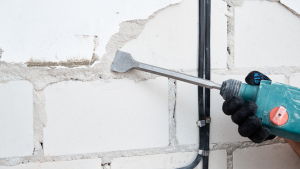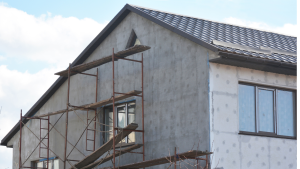PAINTING AND RECOAT Parex USA Finishes usually maintains its appeal after many years of service. Parex USA DPR Coating or Elastomeric Coating can, however, be used to recoat acrylic surfaces if required. The texture and shine of the original finish will change as a result of coatings, it should be understood. Recoat Gel is made to keep the texture untouched. If the coating will cover existing sand or sand fine finish, this is a point that should be taken into particular consideration. Some of the texture in these finishes may be lost due to the aggregate size. It is advised to utilize a tangible sample rather than a digital representation when trying to match the color of an existing Parex USA finish since older finishes can have somewhat changed from their original shade.
The currently installed finish must be tidy and dry. A brush, roller, or the appropriate spray equipment can be used to apply Parex USA Coatings (follow the product data sheet for application). In general, coatings over existing finishes have high surface coverage after a single application. However, two coats can be required depending on the texture and/or color of the current finish. Apply the coating in vertical strokes, overlapping each by half a roller width, when using a roller for a single application. Apply the initial layer in horizontal passes for two coats, and then give it time to dry. The second coat should be applied in a similar manner to a single application, but at a right angle to the first coat.
RENEWAL AND REFINISHING It is advised to send a physical sample to the Parex USA Color Department for evaluation and matching if the final material must be closely colored to the already-existing work. Even so, due to wear and tear or a variation in the applicators’ texturing techniques, the new finish may still seem somewhat different from the original finish. If a wall surface needs to be refinished, refinishing a panel or larger section to an existing break or termination, rather than a smaller patch area, may provide a more acceptable appearance.
Refinishing should be left to an applicator who has prior experience using Parex USA Materials, as per Patching and Repairing. The region must first be cleansed using one of the aforementioned techniques. Second, a skim coat of Parex USA base coat (Cementitious/Acrylic type) should be troweled onto the surface with a stainless steel trowel to a uniform thickness in order to completely fill the voids left by the original texture on the clean and dry existing finish. The reinforcing mesh should be inserted into the wet base coat using installation instructions from the Parex USA EIFS application Guide if increased impact resistance is desired or if reinforcing mesh is required to repair other places. Apply Parex USA Primer if primer was used on the original project to make the new finish more trowelable and maintain color consistency.
Follow the application directions provided in the Parex USA Product Data Sheet for the new finish’s desired finish and texture. Fasteners & Sealants The first sign of water entering a structure should be taken as a problem and should be fixed right away. EIFS systems rely on flashing and sealants, just like conventional wall claddings, to stop moisture from getting behind the cladding’s face.
It is a good idea to routinely examine the installation at these important sites because of this:
- perimeters around windows and doors.
- Expanding joints
- Abuse of different materials.
- Penetrations, such as those near fixtures, outlets, hose bibs, scuppers, etc.
- The top and bottom of the wall’s terminations
- Intersections between the roof and sidewalls Sealant joints may need to be taken out and replaced in order to be repaired.




